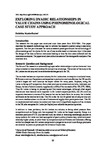Exploring Dyadic Relationships in Value Chains Using Phenomenological Case Study Approach
| dc.contributor.author | Kasturiratne, D | |
| dc.date.accessioned | 2022-07-01T12:42:16Z | |
| dc.date.available | 2022-07-01T12:42:16Z | |
| dc.date.issued | 2016-12-12 | |
| dc.identifier.issn | 2465-5643 | |
| dc.identifier.issn | 2513-2202 | |
| dc.identifier.uri | http://hdl.handle.net/10026.1/19370 | |
| dc.description.abstract |
Introduction The research for this paper was conducted over three years from 2003-2006. This paper describes the research methodology used to validate the research question using a case study approach. The first part discusses the various research paradigms around the methodology of phenomenology and the choice for the use of case studies based on interview data. It discusses the design of the data collection instrument leading to how the data were collected and the interviews conducted. The paper concludes with a discussion of the strategies for analysis of the interview data. Research Question and Background The focus of the research is understanding buyer seller relationships in value chains and how value is created in these relationships for competitive advantage. The context of the study is the Sri Lankan tea industry and its cross border exchanges with the UK. The tea trade has been an important industry for Sri Lanka since its inception in colonial times. With over a century of experience and expertise in production and manufacture, the UK was Sri Lanka’s largest and most lucrative tea export market for many years. However, today, Sri Lanka is facing stiff competition from other producer countries such as India, Indonesia and Kenya, the last of which currently supplies about 60% of the tea needs of the UK (ITC, 2004). Thus Sri Lanka is losing its pioneering and first-mover advantages. Although other export destinations have become more important in Sri Lanka’s exports portfolio, the UK is still an important destination in terms of the lessons that can be learnt from the country that is hailed worldwide as the trend-setter in tea. The UK is also the hub for global tea industry activity and acts as an interface where a multitude of international supply chain participants meet. The UK is a sophisticated and mature tea market and there is still a significant segment of tea drinkers in the UK who recognise Sri Lanka (or Ceylon) as a valuable tea producing nation. In addition to these problems, the Sri Lankan tea industry is facing added pressure from competitors such as Kenya who has surpassed Sri Lanka as the largest exporter. Kenya is a dominant producer of CTC (cut-tear-and-curl) tea which is becoming increasingly popular in many markets. Sri Lanka as a leading supplier of good quality orthodox teas, which command relatively higher prices, is under threat by competitors such as Vietnam and Indonesia offering similar but cheaper teas. Sri Lankan margins are in danger as more and more foreign producers are attracted by premium prices paid for orthodox Ceylon teas | |
| dc.format.extent | 23-39 | |
| dc.language.iso | en | |
| dc.publisher | Sri Lanka Journals Online (JOL) | |
| dc.title | Exploring Dyadic Relationships in Value Chains Using Phenomenological Case Study Approach | |
| dc.type | journal-article | |
| plymouth.issue | 2 | |
| plymouth.volume | 2 | |
| plymouth.publication-status | Published online | |
| plymouth.journal | NSBM Journal of Management | |
| dc.identifier.doi | 10.4038/nsbmjm.v2i2.25 | |
| plymouth.organisational-group | /Plymouth | |
| plymouth.organisational-group | /Plymouth/Faculty of Arts, Humanities and Business | |
| plymouth.organisational-group | /Plymouth/Faculty of Arts, Humanities and Business/Plymouth Business School | |
| plymouth.organisational-group | /Plymouth/Users by role | |
| plymouth.organisational-group | /Plymouth/Users by role/Academics | |
| dcterms.dateAccepted | 2016-01-01 | |
| dc.rights.embargodate | 2022-7-2 | |
| dc.identifier.eissn | 2513-2202 | |
| dc.rights.embargoperiod | Not known | |
| rioxxterms.versionofrecord | 10.4038/nsbmjm.v2i2.25 | |
| rioxxterms.licenseref.uri | http://www.rioxx.net/licenses/all-rights-reserved | |
| rioxxterms.type | Journal Article/Review |


